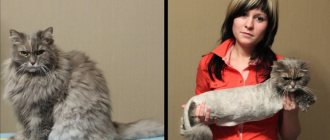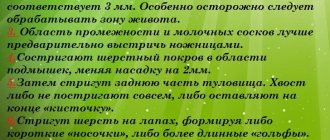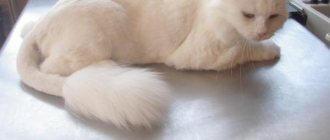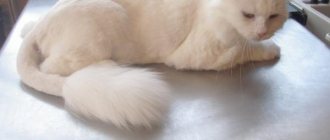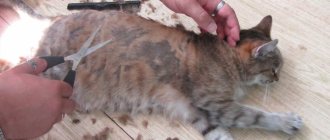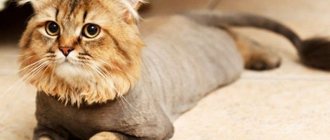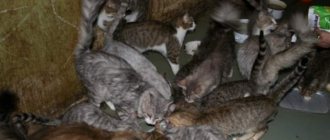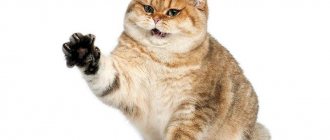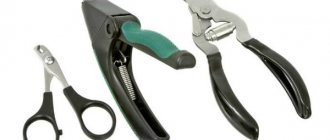Grooming (shaving) cats and kittens is a procedure that can be used for medicinal and some other purposes (hygienic haircut, etc.). Let's figure out what these cases are, whether and how to shave a cat correctly and beautifully at home.
What will be discussed in the article is based on the author’s personal experience, as well as on the experience of other cat breeders and on theoretical knowledge of cat physiology. Somehow the groomers mistakenly shaved my cat to 3mm instead of combing out the shedding fur as I asked. As a result, my mood was ruined for a long time, and we are still seeing the consequences to this day. I must say that I personally am against shaving cats for the sake of beauty or the convenience of the owners, but I cannot help but notice that many other owners, including professional breeders, practice this procedure. Therefore, let's look at the problem from different angles.
Article continues after advertisement
How to cut a cat's hair at home: tips
Grooming a cat at home is not an easy task, but still doable. This may be necessary if your cat:
- Fluffy and the fur is matted.
- You want to give him a new hairstyle.
- Your cat got into the paint or glue.
Actually, cutting a cat's hair is like trying to cut a child's hair. He is not interested in your arguments that it will be prettier or more hygienic. “The Tale of the Cat that Walks by itself” clearly shows that of all domestic animals, cats are the ones that demonstrate an independent character. If your pet decides that food or play is more interesting to him than a haircut, he will ignore this offer and you will have to “negotiate” with him on mutually beneficial terms.
How to cut a cat's hair at home?
Let’s immediately discard such inhumane methods of grooming a cat, such as forcible restraint or general anesthesia. After all, you don’t want your cat to lose faith in the kindness of his owner?!
- And you will be left with one option. Feed the cat to his fill with his favorite food, relax him by scratching behind the ear, massaging his back, and quietly sneak up on him with scissors.
- Instead of scissors, you can try using an electric hair clipper. But if such a machine is too noisy, your cat may get scared and run away.
- But the comb-trimmer for removing the undercoat of cats is easy to use, and the stroking that the cat will feel during this procedure will only be pleasant for him. This comb resembles a razor with teeth at the end.
Owners of furry cats face a lot of troubles during molting. Pieces of wool on the floor and beds, as well as tangles that cannot be combed out, will complete the bleak picture.
Advice for those who don’t know how to remove mats from a cat? If the lumps are located close to the animal's skin, do not try to pull them together with the skin and cut them off with scissors. So there is a very high risk of injuring the skin. Take small nail scissors and literally cut off the matted fur, millimeter by millimeter.
Why cut your cat's hair?
After clipping, the coat is easier to comb.
In fact, the procedure is quite popular and in demand in grooming salons. Yes, there are owners who bring their beloved furry dogs for a haircut in order to win at the exhibition, have an extravagant look and have cute photos for Instagram or social networks.
But there are also those who know that such hairstyles have many advantages for the health of their children. What are the advantages of a unique hygiene procedure?
- getting rid of tangles, which have become too numerous and can no longer be untangled with ordinary brushes;
- normalization of digestion: unsightly and hanging hairballs, disfiguring the cat, can cause blockage of the stomach and intestines if accidentally swallowed during another lick;
- order in the house: after a haircut, the wool does not lie everywhere and does not cause the owner to have bouts of quiet rage when, once again, black pants have turned into a shaggy hedgehog;
- easier combing;
- peace of mind between the cat and the person: you won’t have to tyrannize your pet and freak out from the daily tearing apart of tangled areas of fur;
- relief from suffering: in summer the animal will no longer suffer from the heat.
By the way, the presence of tangles is the cause of dermatological problems: the skin under them heats up more, creating favorable conditions for the development of pathogenic microflora. Frequent formation of “felt balls” indicates a metabolic disorder or vitamin deficiency and requires consultation with a specialist.
Cat haircuts: photos
Sometimes it happens that after the owner got a cat, he suddenly realizes that he needed to get a dog. The result of such a mistake will be an attempt to convert a cat into a dog. We bring to your attention cat haircuts. Admire the cat as a poodle .
Grooming a cat like a poodle
Or this option - a cat in the role of a lion .
Grooming a cat like a lion
And the owner of this cat not only cut, as it seemed to him, the excess hair, but also increased the missing fur. The result of such efforts was a cat with an Elvis Presley . It’s a pity that cats cannot express to their owners in a language they understand everything that they think about them.
Grooming a cat like Elvis Presley
The owner of this cat decided to joke and, secretly from the family, gave the cat an “ accordion ” haircut. The joke was not entirely successful because the joker’s mother was very upset when she saw her shorn pet.
Cat before and after haircut
Sometimes you can see cat haircuts that were actually appropriate and beneficial for the animals. The photo below shows a fluffy cat after molting.
Persian cat before haircut
Removing excess hair will not hurt such a cat. It’s just important not to overdo it.
Persian cat after haircut
Fashionable haircuts for cats in the form of a lion's mane, a tiger or a dragon may cause affection for the owners or guests, but your cat is unlikely to like it.
If a cat's fur is too short, his body's thermal balance will be disrupted, and even while in an apartment he can catch a cold.
If you decide to cut your cat's hair at home, be patient and use a pet clipper. Cats do not tolerate interference in their privacy. Be prepared for the fact that your pet will run away from you without completing the transformation into a lion or dragon and you will have to “persuad” him with a treat or finish the haircut the next day. But there are cats who categorically do not want any new hairstyles and after a haircut they look pitiful and unhappy. Nature gave cats fur for a reason. It protects the cat from both hypothermia and overheating. It's better not to upset this balance.
To cut or not to cut
It is important to understand that not all cats can and should be subjected to this procedure. So the following are a kind of contraindication:
- colorpoint and tipping colors - as the fur grows on the back and belly, it will become several tones darker than before cutting;
- disgusting character and violent temperament, when the animal does not give in to any persuasion. Of course, you can cut it under anesthesia, but in this case, evaluate all the possible risks associated with the administration of narcotic drugs: cardiac arrest, coma, failure of the liver and kidneys. As a last resort, sedatives and muscle relaxants are used instead of drugs, but only after approval of the appropriateness of their use by a specialist and under his clear guidance;
- Without an urgent need, there is no point in cutting short-haired cats - the heat does not particularly interfere with normal life activities, and they never have mats;
- Smooth-haired animals are cut only in extreme cases, for example, when they have been worn in oil paint and it is easier to shave the animal than to try to rub off the matted multi-colored wool.
Haircut for a cat Dragon
Grooming a cat's dragon
A haircut for a cat's dragon is done with an electric clipper. Your task will include
- Make the cat bald on the stomach and sides.
- Leave the head, tail and stripe on the back unshaven.
- Use patterns in the form of scales to decorate unshaven areas.
If your cat does not have nerves of steel, you will have to call for help from friends who will hold him during this not very pleasant procedure for him. Before cutting your cat's hair at home, weigh all the pros and cons of such a decision. Cutting the fur too short will harm your cat's health. Your pet may end up with hypothermia and psychological shock.
How to carry out the procedure
The hair on a cat's head is usually not cut.
- The cat is fixed on its side by its hind and front legs.
- If the animal is overly aggressive, a collar is put on the animal to prevent it from biting.
- First they cut the tangles with scissors, and then take the clipper and continue working on the sides and back.
- The fur on the paws is removed last, if necessary at all.
- When working in the abdominal area, exercise maximum caution and carefully avoid the nipples and intimate area. It is better to cut the area around with scissors in advance so that all the delicate parts are clearly visible.
- The hairstyle is not done on the head; in extreme cases, it can be shaped using thinning scissors.
- The tail is cut at will and as the hairdresser's imagination allows.
It is important to carry out all manipulations as carefully as possible so as not to injure the animal. It is not always possible to completely trim an animal at once - do not be upset: even though the procedure will take place in several stages, but all participants in the “acting” will remain safe and sound.
After grooming, the cat should be washed and dried with a hairdryer. Although, to avoid unnecessary stress, you can simply wipe your pet with a damp cloth or suede cloth to remove cut and stuck hairs.
In the cool season, the trimmed miracle needs to be provided with a comfortable indoor microclimate without drafts and the possibility of hypothermia.
Varieties
Cat haircuts are divided into two groups: model and hygienic. The latter pursue very specific goals and are carried out in order to protect the animal from overheating and tangles, as well as for veterinary indications. These include diseases of the skin and gastrointestinal tract, increased secretory activity of the sebaceous and para-anal glands, as well as the senility of the pet, when it is no longer able to cope with its fur on its own.
Model haircuts are performed exclusively for decorative purposes to make the animal more attractive, as well as before cat shows. The most common of them are haircuts like a lion, like a dragon, and like a dinosaur. The puma hairstyle is also very popular and is a simplified version of the lion haircut. The only difference is the design of the tail: for example, if in a “puma” it is cut almost bald, then in a “lion” it repeats the shape of a real lion’s tail with a fluffy tassel.
However, the most creative can be called the “dragon” haircut, which includes various variations of cutting symbols, letters, ornaments and figures on the back of the animal. Despite the rather exotic appearance of the pet, most veterinarians warn owners against performing this haircut. This is due to the fact that after cutting the patterns, the fur on the pet’s skin becomes uneven, which greatly disrupts thermoregulation and does not allow the body to adapt to this type of heat transfer.
A graduated hairstyle has a much stronger negative impact on the cat’s condition than uniform haircuts, to which the body adapts over time. The same, but to a slightly lesser extent, applies to the “socks”, “sock socks” and “puss in boots” haircuts, which are also very popular among cat owners. Among exhibition haircuts, “harlequin”, “modern” and “continental chic” are very popular.
If the cat is injured
If it was not possible to avoid injury from scissors or clippers when grooming a cat, immediate measures must be taken to eliminate the consequences:
- wipe the cut area with a disinfectant;
- apply healing ointment with a bandage or plaster; it is better to use a bandage so that the pad does not fall off when moving.
In case of deep and lacerated wounds, surgical intervention is required - it is better to take the cat to the veterinarian or call a doctor at home. Eye damage is especially dangerous; in this situation, consult a doctor immediately.
Choosing Cat Grooming Tools
The haircut can be carried out using scissors (medium size, sharp with rounded ends) or a clipper, preferably silent, so as not to frighten the pet. The latter method is more effective and safer - there is practically no possibility of injuring the animal, and the result is guaranteed: a uniform haircut with the ability to choose the desired length of fur.
Auxiliary tools:
- soft comb;
- textile;
- hydrogen peroxide or chlorhexidine (needed if you injure an animal);
- toys and treats;
- table (or other surface).
It is better to immobilize the cat during the procedure. For example, wear a special collar. It is better for the second person to hold the cat and calm it while the first haircut is performed.
If the animal is very aggressive, it is better to visit a veterinary clinic. In some cases, anesthesia may be needed. It is worth doing it only if there is no other option. For example, a cat is covered in tangles and it’s hard for him.
Breeds of red cats
A cat with a red color can be found among both purebred and mongrel pets. "Ryzhik" can also be fluffy or short-haired.
British cat
A short-haired cat with a strong, muscular body and thick, silky fur. The most popular color is smoky blue, solid or tabby. Red shorthair cats of the British breed are rare and there are much fewer girls among them than boys.
In detail - about red British cats.
But among the British, sometimes there are long-haired cats; they look especially interesting in their white and red color. Breeders sought to obtain new shades, and as a result of crossing a British cat with Somali and Persian breeds, luxurious, lush fur was fixed in the genotype.
Siberian cat
Representatives of this breed have long, lush hair (with hypoallergenic properties) and a double undercoat. Siberian fluffy ginger cats with eyes of a rich orange-amber hue are a rarity; many catteries are separately engaged only in their selection.
Even more unique are Siberian ginger cats with a tabby striped pattern and white accents on the shirtfront and paws. There are no such animals in the group of smooth-haired pets.
Maine Coon (Manx coon cat)
A very large cat, its height is 1 meter in length and its weight exceeds 8 kg. Unlike other breeds, which reach their maximum size by the age of 2, Maine Coons grow until they are 3-5 years old.
Purpose
One of the main reasons why cats are cut is due to matting and matting. In this regard, the main purpose of a haircut is to relieve the animal of the unpleasant sensations that arise as a result of the skin being pulled together by matted hair.
Long-haired cats suffer from this especially often, as these troubles happen very often. Once you skip brushing, the animal begins to experience noticeable discomfort and become very nervous. Moreover, blood circulation in tight skin is impaired, resulting in unbearable itching.
Another, no less important purpose of haircuts is to prevent the ingestion of large amounts of fur during licking, which often provokes serious problems with the pet’s digestion.
An equally important reason for cutting excess hair is too hot a climate, as well as an increase in room temperatures in summer and winter. It can be very difficult for animals, especially long-haired ones, to tolerate air temperatures above 35 degrees, so it is simply necessary to alleviate the pet’s condition in such cases. Another common problem with wool cats is contamination of their long fur with excrement while going to the litter box.
In this case, there can be two ways out of the situation: constantly washing the contaminated area or cutting off the hair around the anus.
However, the latter procedure does not add attractiveness to the cat, so it is better to trim the entire cat rather than clipping individual areas.
In addition to the hygienic component, there is also an aesthetic aspect to cat grooming. A properly trimmed pet looks very beautiful and well-groomed, attracting the attention of others and pleasing the eyes of its owners. In addition, intensively shedding animals also require trimming, otherwise they will literally fill the house with their hair. But if a cat sheds too much and for a long time, you should show it to the veterinarian, since intense hair loss can be caused by a lack of vitamins or the onset of a serious illness.
Haircut instructions
First, the table is treated with an antiseptic and the instruments are disinfected. Then the claws are trimmed. The cat is secured so that it lies still. When he tries to escape, they put a plastic collar on him. First, use a clipper (nozzles No. 3-5) to cut the hairs on the sides, then treat the back and stomach. They act very carefully near the nipples, in the perineum.
For the armpits, change the nozzle to No. 2. Shave the paws starting from the top, going down as far as necessary. The hair on the tail is cut so that 1/3 of the hair remains, at least a tassel. To avoid damage to the skin, it is slightly stretched.
The tangles are cut off with scissors before the hairstyle. If missed during the preparatory examination, then as soon as it is found. The coat can be cut with or against hair growth. When the procedure is completed, the cat is wiped with a damp cloth or doused with warm water and washed with shampoo. Then dry with a towel or hairdryer.
Options for common haircuts
The French Lion hairstyle is very popular . This hairstyle suits any cat, but cats with thick, long hair look especially impressive. It is ideal for the summer heat. The cat is cut like a lion, leaving only the mane, a tuft on the tail, and hair on the paws below the knees. Other types are also popular.
Fashionable haircut options
Dragon has become one of the most popular fashionable haircuts . The coat is trimmed with narrow or wide triangles, forming a mohawk. Paws and head are not cut. Dragon models are different. It’s difficult to do a fashionable haircut on your own; it’s better to take your cat to a specialist or invite a groomer to your home.
Partial haircut options
These include haircuts that are close to the natural cover or with partial shaving. For example, Continental, Harlequin, Modern . Such haircuts emphasize the extravagance of the cat.
How long does a cat's hair grow after shaving?
How long a cat's fur grows after trimming and shaving is mainly influenced by genetics and nutritional balance. For example, my cat gained about 2 mm in length in 1-2 days. This is the normal rate of hair growth for cats. At first it looked like a waffle towel - a pitiful sight, although it was pleasant to touch (reminiscent of a mouton). Two weeks passed and the animal was in more or less decent shape. After about six months, as the groomers promised, the coat regained its previous length. On average, this is what happens.
However, as expected, the blue point cat was very dark on the body. It looks disgusting, so we're waiting for it to fade. There is little hope that after molting, the previous light shade will at least be restored a little.
But many owners complain that the cat’s hair does not grow well after a haircut. This also happens. And in rare cases, there may be areas of baldness where the hair does not recover at all.
Preparing for a haircut
The preparatory steps are as follows:
- Examine the cat. If there are skin lesions, it is recommended to reschedule the haircut. However, you don’t have to do this; then the wounded area needs to be carefully trimmed so that the wound is visible.
- Wash your pet.
- Decide on a tool. It should be well pointed.
- Choose the right time. The best thing is a period of rest, since while the cat is awake, it can injure both itself and the person.
The consequences of cutting or shaving
When dehairing a furry friend, the owner must be prepared to deal with the consequences of their actions. If you decide to shave or trim your cat, there is a high risk of encountering a violation of thermoregulation. The fur of cats performs the same functions as clothing for humans. In cold weather it retains heat and in hot weather it prevents overheating. Forced deprivation of natural protection can cause colds, dermatological diseases, burns and heat stroke.
Another trouble is problems with orientation. Vibrissae are located throughout the animal’s body, helping it navigate in space day and night. Their removal leads to insecurity, excessive caution or sudden attacks of aggression. The animal may hide under sofas, in closets, or suffer from stress.
The desire to get a cat with an unusual appearance or lack of time for proper care leads to disastrous consequences. The long-haired beauty becomes an incomprehensible ball of fur with curly hair, prone to the formation of tangles, and yesterday’s quiet and neat girl vindictively leaves traces of her life activity throughout the house, not forgetting about the “gifts” in the owner’s bed. This behavior is justified by stress - not all pets are loyal to interference in their personal space.
References to the fact that felines are very hot in summer cause ironic smiles among veterinarians. Most lovers of cat haircuts cannot answer the legitimate question of why owners don’t shave their heads and eyebrows in hot weather. Groomers' recommendations to trim long-haired breeds twice a year do not indicate care, but a desire to increase their own income.
join the discussion
Share with your friends
Grooming cats is a very hot topic and raises many questions among their owners. This is a very specific and serious matter, so before you decide to trim your pet, you need to familiarize yourself with the intricacies of the process and weigh the pros and cons.
How often can you cut your hair?
The frequency of cosmetic procedures depends on the age of the animal, its health, and the rate of hair regrowth. It is recommended to trim your cat 2-3 times annually. Unscheduled ones are done as needed - before exhibitions, competitions. However, an exception is sometimes made for longhaired dogs. Especially with poor hygiene. Then they trim and shave as needed or every three months.
Some cats have a hard time withstanding heat (for example, Persians). Therefore, it is recommended to cut them in spring and summer. Such rocks quickly become overgrown, so they are trimmed 2-3 times annually. Less often – cats with medium pile. For them, it is enough to trim the animal once every 12 months. In addition, a well-groomed pet is easier to treat for parasites and skin diseases.
What to do if you shave your cat?
Finally, some practical advice in case you have an almost hairless cat running around the house, which until recently was fluffy.
- Don't laugh at her appearance. Your ridicule may make her depressed.
- Make sure that the house is warm at first and there are no drafts. If the house is cool and your cat is freezing, I recommend training her to wear light clothing.
- While the cat's fur is growing, it may need extra calories for warmth, so it may be necessary to increase its daily food intake slightly. But you still can’t go beyond the norm in terms of weight and age. If you increase the portion too much, the cat will become overweight.
- If your cat is very stressed after a haircut, you need to give her a day or two to calm down. Most calm down without outside help. But if the stressful condition does not go away, you will have to ask the veterinarian for a mild sedative.
- If a cat licks itself after a haircut, this is normal. Firstly, this is how she tries to restore order to the fur. Secondly, it clogs the foreign odor obtained during the procedure. Thirdly, this is how the cat “washes away” stress.
- If a cat is trembling after a haircut, this may be due to both impaired heat exchange, that is, she is cold, and stress. If the cat’s behavior has not changed in general after the haircut and there is only tremors, then clothing is enough to keep her warm.
- If your cat itches after a grooming, this may be due to discomfort due to the new length of fur, as well as irritation and damage to the skin during the procedure. Cats can also itch because less than 3 mm is left: the itching will stop as soon as the fur grows a little. In addition, the animal may be bothered by the cut hairs remaining on the skin: this happens if the cat is not bathed after shaving.
Rate and share!
